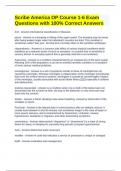Scribe America OP Course 1-6 Exam
Questions with 100% Correct Answers
ICD - Answer-international classification of diseases
ptosis - Answer-is a drooping or falling of the upper eyelid. The drooping may be worse
after being awake longer when the individual's muscles are tired. This condition is
sometimes called "lazy eye", but that term normally refers to the condition amblyopia.
Hypoesthesia - Answer-is a common side effect of various medical conditions which
manifests as a reduced sense of touch or sensation, or a partial loss of sensitivity to
sensory stimuli. In everyday speech this is generally referred to as numbness.
Anisocoria - Answer-is a condition characterized by an unequal size of the eyes' pupils.
Affecting 20% of the population, it can be an entirely harmless condition or a symptom
of more serious medical problems.
meningismus - Answer-is a set of symptoms similar to those of meningitis but not
caused by meningitis. Whereas meningitis is inflammation of the meninges (membranes
that cover the central nervous system), meningism is caused by nonmeningitic irritation
of the meninges, usually associated with acute febrile illness,[1][2] especially in children
and adolescents.
testicles descended - Answer-is a condition when one or both of the testes have not
descended into the scrotum at birth, but stay in the abdomen or only move part way
down into the scrotum
Stridor - Answer-a harsh vibrating noise when breathing, caused by obstruction of the
windpipe or larynx.
Post-ictal - Answer-is the altered state of consciousness after an epileptic seizure. It
usually lasts between 5 and 30 minutes, but sometimes longer in the case of larger or
more severe seizures, and is characterized by drowsiness, confusion, nausea,
hypertension, headache or migraine, and other disorienting symptoms.
somnolence - Answer-(alternatively "sleepiness" or "drowsiness") is a state of strong
desire for sleep, or sleeping for unusually long periods (compare hypersomnia).
AAA - Answer-Abdominal aortic aneurysm
modifier - Answer-A code that indicates a service or procedure is unique or changed
E&M - Answer-evaluation and management
,LOS - Answer-level of service
laterally - Answer-left or right
Problem focused - Answer-A history or exam that focuses solely on the chief complaint
RAF - Answer-Risk adjustment factor- assesses the complexity of care
HCC code - Answer-A code that allows greater reimbursement due to the patient's
complexity and health risk
Superbill - Answer-A bill, submitted to the insurance company, that reflects the services
provided to the patient
ICD codes - Answer-= diagnosis
Although providers are ultimately responsible for choosing the ICD codes, you must
make sure your documentation supports the code(s) they choose.
ICD codes example - Answer-ICD Diagnosis: Moderate persistent asthma with acute
exacerbation, without status asthmaticus
Necessary documentation:
Moderate- some limitation of activity
Persistent- occurs daily
Acute exacerbation- worse today requiring nebulizer treatment
Without status asthmaticus- returned to baseline after nebulizer
(Care: $250)
Deficient Documentation:
Pt is here for asthma.
Used nebulizer today
(Compensation: $125)
Every word of
the ICD
diagnosis must
be supported
by your
documentation.
ICD codes example - Answer-ICD Diagnosis: Moderate persistent asthma with acute
exacerbation, without status asthmaticus
HPI supports the diagnosis
,Moderate: The pt reports some limitation of activity due to asthma, as she cannot fully
participate in gym class.
Persistent: Episodes of asthma occur daily and are usually
treated with an inhaler.
With acute exacerbation: Asthma became worse today, requiring nebulizer treatment.
Without status asthmaticus: Episode resolved after neb and pt is currently
asymptomatic.
ICD codes - Answer-TIPS FOR ICD SUCCESS
1. Documentation must be thorough and detailed
1. Each word of the ICD diagnosis must be supported
by your documentation
1. Avoid ICD codes that include the word "unspecified".
These will result in less reimbursement.
ICD codes- elements - Answer-How can you make sure the ICD code is supported by
your documentation?
Remember the elements:
onset, timing, location, associated symptoms, quality, severity, modifying factors,
context
ICD codes- elements - Answer-Quality:
ICD Fracture:
Transverse, oblique,
spiral, etc.
Onset:
ICD Headache:
Acute, chronic,
recurrent, etc.
Context:
ICD COPD: Hx of
smoking, factory
work, etc.
Severity:
ICD Renal Failure:
Stage 1, 2, 3, 4, end-
, stage
Location:
ICD Extremity Injury:
Upper/lower
Laterality - right/left
Associated
Symptoms:
ICD URI: Fever,
cough, etc.
Specific
ICD codes- specificity - Answer-• ICD codes range from general to specific
• More specific codes are better and result in higher
reimbursement
ICD CM | Diagnosis
I49.9 Arrhythmia, NOS
I48.2 Atrial fibrillation
E10.9 Diabetes type I
E10.65 Diabetes Type I, Uncontrolled
ICD codes - Answer-specific and supported
An ICD compliant diagnosis is one that is specific and supported elsewhere in the
documentation.
HPI: This is a 65 y/o female with a history of rheumatoid arthritis complaining of swelling
and pain in her right wrist for several years. --> ICD Diagnosis: Chronic rheumatoid
arthritis of the right wrist
ICD Code DO's - Answer-Discuss elements with your provider prior to entering the room
Ask for missing elements immediately
upon exiting the room, before moving
to the next patient
Watch as your provider enters the diagnoses and make sure every word of the
diagnosis is supported by your documentation
Prompt your provider for clarification
as needed
ICD DON'Ts - Answer-Do not ask for clarification in front of the patient




